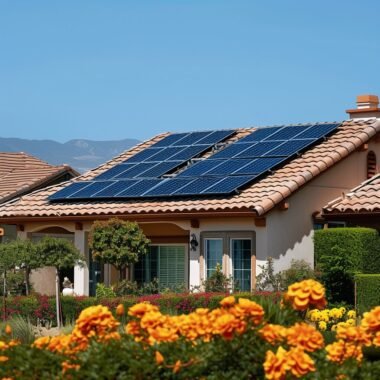To accurately calculate the number of solar panels needed, homeowners should review their kilowatt-hour (kWh) energy usage, typically found on their power bill, and understand the output of different solar panel models.
Call now to get a free quote
Solar System Size for San Diego Homes
When sizing a solar panel system for a San Diego home, homeowners must consider their individual energy usage and local climatic factors. A precise calculation ensures that the solar system meets the household’s energy needs efficiently.
Energy Usage Analysis
Each homeowner’s energy usage is unique and is the fundamental factor in determining the size of the solar energy system required. One must assess their electricity bills to determine their kWh usage over time. This analysis typically accounts for monthly fluctuations to provide a comprehensive understanding of annual energy requirements.
Tools such as the California Solar Initiative’s Solar Calculator assist in estimating a system size recommendation by factoring in this historical usage data.
Peak Sun Hours and Climate Factors
The effectiveness of a solar energy system in San Diego is also influenced by peak sun hours and local climate conditions. San Diego generally experiences high levels of solar irradiation, a critical consideration for the operational efficiency of solar panels.
Solar Panel Size Calculator
A solar panel size calculator is an essential tool for homeowners in San Diego looking to install a residential solar energy system.
This calculator takes into account the average electricity usage of the household, available sunlight hours, and the wattage of the solar panels being considered. To get started, one should gather their electricity bills to determine their average electricity consumption in kilowatt-hours (kWh).
Homeowners in San Diego can typically expect around 5.5 hours of sunlight per day, which will influence the total number of solar panels needed.
For example, if a San Diego home typically uses 600 kWh per month, and considering an average solar panel produces approximately 250 watts in optimal conditions, the following calculation would apply:
- Monthly Usage: 600 kWh
- Daily Usage: ( \frac{600 \text{ kWh}}{30 \text{ days}} \approx 20 \text{ kWh per day} )
- Required System Size: ( \frac{20 \text{ kWh}}{5.5 \text{ hours of sunlight}} \approx 3.64 \text{ kW per day} )
- Number of Panels: ( \frac{3640 \text{ watts}}{250 \text{ watts per panel}} ) ≈ 15 panels
Solar Panel Efficiency and Output
The efficiency of solar panels is a crucial aspect when determining the overall solar energy system size. Solar panel efficiency indicates the amount of sunlight the panel can convert into usable electricity.
On average, residential solar panels have an efficiency rating between 15-20%. Higher efficiency ratings generally mean fewer panels are required to meet the same energy needs, but these panels may come at a higher cost.
Output is measured in watts and typically, a standard panel will have an output rating of around 250 to 350 watts.
However, technology improvements are seeing this number steadily increase. When calculating the necessary size of your solar energy system, it is vital to know the output ratings of your chosen solar panels to accurately predict how much energy they will produce.

Solar System Costs and Incentives
Costs: The total cost to install a solar system varies based on the solar system size needed for a home.
In San Diego, the size of the solar system will influence the solar panel cost and installation cost. Prices can range significantly but typically include the panels, inverter, mounting hardware, and installation labor. A solar panel’s efficiency and output also affect the total system cost, as higher efficiency panels may come at a premium.
Incentives: Homeowners in San Diego can take advantage of several incentives to reduce the out-of-pocket expenses for solar systems. The federal solar tax credit allows homeowners to claim a portion of their solar installation costs on their federal taxes.
Additionally, rebates may be available at the state or local level, and net metering programs can provide credit for the electricity that solar systems contribute to the grid.
Analyzing the Payback Period
The payback period is a critical factor in evaluating the investment in a solar system. It’s the time it takes for the energy savings to cover the initial costs of the solar panels and installation.
Factors influencing the payback period include the cost of the system, the amount of electricity it generates, and the available incentives.
- A solar cost analysis must account for monthly energy savings against the total solar system cost, including any increases in property value.
- The net metering policy in California allows homeowners to receive bill credits for excess energy, impacting the payback period favorably.
Comparing Top Solar Panels and Inverters
When considering solar panels in San Diego, homeowners should evaluate panel efficiency, which influences the amount of solar electricity produced.
High-efficiency solar panels are ideal, particularly if the roof space is limited. Panels with efficiencies ranging from 15% to 22% are common, with the higher percentages being more efficient and often more expensive.
Homeowners should also compare inverters as they are pivotal for converting solar power into usable electricity.
Two main types are string inverters and microinverters. String inverters are cost-effective and suitable for panels placed in direct sunlight without shading.
Microinverters, although more expensive, optimize the output of individual solar panels, enhancing the overall efficiency of the solar power system.
Energy Storage and Batteries
Integrating batteries into a residential solar system size in San Diego can provide energy storage to use solar electricity during the night or on cloudy days.
The capacity of the battery should match the energy needs of the home and the output capacity of the solar array.
Batteries like the Tesla Powerwall or LG Chem can store surplus energy, ensuring consistent power supply and aiding in energy independence.
Call now to get a free quote
Understanding Maintenance and Lifespan
Solar panel systems are designed to be low-maintenance, but certain routine checks and cleaning can extend their operational life. In San Diego, the typical lifespan of a solar panel installation can range up to 25 to 30 years.
Regular monitoring of the system’s performance is critical.
A drop in efficiency can sometimes indicate that maintenance is needed, such as cleaning or repairs.
The cost to maintain solar panels is generally low, but when upkeep is neglected, the solar panel cost in San Diego could increase due to the need for repairs or even premature replacement.










